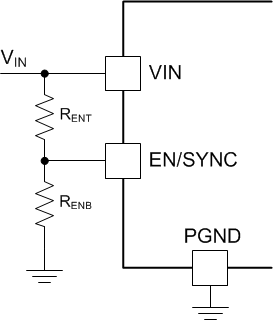SNVSAO6C September 2017 – March 2018 LMZM33603
PRODUCTION DATA.
- 1 Features
- 2 Applications
- 3 Description
- 4 Revision History
- 5 Pin Configuration and Functions
- 6 Specifications
-
7 Detailed Description
- 7.1 Overview
- 7.2 Functional Block Diagram
- 7.3
Feature Description
- 7.3.1 Adjusting the Output Voltage
- 7.3.2 Feed-Forward Capacitor, CFF
- 7.3.3 Output Current vs Output Voltage
- 7.3.4 Voltage Dropout
- 7.3.5 Switching Frequency (RT)
- 7.3.6 Synchronization (SYNC)
- 7.3.7 Input Capacitors
- 7.3.8 Output Capacitors
- 7.3.9 Output On/Off Enable (EN)
- 7.3.10 Programmable Undervoltage Lockout (UVLO)
- 7.3.11 Power Good (PGOOD)
- 7.3.12 Overcurrent Protection (OCP)
- 7.3.13 Thermal Shutdown
- 7.4 Device Functional Modes
- 8 Application and Implementation
- 9 Power Supply Recommendations
- 10Layout
- 11Device and Documentation Support
- 12Mechanical, Packaging, and Orderable Information
Package Options
Mechanical Data (Package|Pins)
- RLR|18
Thermal pad, mechanical data (Package|Pins)
Orderable Information
7.3.10 Programmable Undervoltage Lockout (UVLO)
The LMZM33603 implements internal UVLO circuitry on the VIN pin. The device is disabled when the VIN pin voltage falls below the internal VIN UVLO threshold. The internal VIN UVLO rising threshold is 3.9 V (maximum) with a typical hysteresis of 300 mV.
If an application requires a higher UVLO threshold, a resistor divider can be placed on the EN/SYNC pin as shown in Figure 31. Table 7 lists recommended resistor values for RENT and RENB to adjust the UVLO voltage.
To insure proper start-up and reduce input current surges, the UVLO threshold must be set to at least (VOUT + 1.5 V) for output voltages ≤ 5 V and at least (1.3 × VOUT) for output voltages > 5 V. TI recommends to set the UVLO threshold to approximately 80% to 85% of the minimum expected input voltage.
 Figure 31. Adjustable UVLO
Figure 31. Adjustable UVLO Table 7. Resistor Values for Adjusting UVLO
| UVLO (V) | 6.5 | 10 | 15 | 20 | 25 | 30 |
|---|---|---|---|---|---|---|
| RENT (kΩ) | 100 | 100 | 100 | 100 | 100 | 100 |
| RENB (kΩ) | 35.7 | 20.5 | 12.7 | 9.31 | 7.32 | 6.04 |